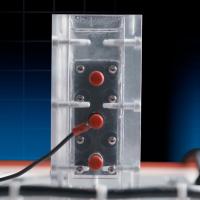Without a basic understanding of gene expression, education systems risk not helping students realize their full potential. There’s a common misconception in education that frames human potential as a force whose nature and degree are genetically predetermined from birth: some kids have great potential, others, not so much.
Genomic research shows that’s mostly fiction. The human genome contains approximately 20,000 genes, but only about 10% of those genes get expressed throughout life. It’s important which genes get expressed, because the resulting processes can affect everything from cognitive capabilities to the development of disease.
So what drives gene expression? It’s not genes themselves acting on a preset list of instructions; that’d be like saying “a recipe decides when a cake is baked,” as neurobiologist Robert Sapolsky wrote in his book “Behave”. Salpolsky suggests the idea of genetic determinism is devastated by what research shows to be the answer: environment and our interactions with it. This is the process of epigenetics.
How epigenetics shape our lives
Epigenetics — which means “on top of” genetics — refers not to changes in our DNA, but rather how factors like childhood experiences, relationships, diet, and physical activity influence which of our genes get turned “on” or “off.”
Epigenetic changes occur throughout our entire life.
Although the ways our genes get expressed in early life, including our first years but also our adolescence, represent critical periods of development that can have lifelong impacts.
“If very positive things develop us in our families and our schools and our communities, we’re going to influence that 10% [of genes],” Dr. Pam Cantor, founder and senior science advisor for Turnaround for Children, told Freethink. “But if our lives are filled with adversity and stress, those incredible genes are not going to get expressed.”
That’s why Turnaround For Children, a nonprofit that equips educators with science-backed tools and strategies, is focused on using insights from epigenetics research to design educational environments in which young people can develop their full potential.
“So much of who we become is because of the environments, experiences, and relationships that we are exposed to,” Cantor told Freethink.
“Gene expression is our potential — this is what we could be if the context of our lives supported that expression to reveal itself.”
Adversity, stress and academic performance
Although some schools may offer mental-health resources, they’re generally ill-equipped to handle student stress in a targeted way. That’s a problem, given the growing body of research showing that young people are especially likely to suffer from stressors like anxiety and depression. A 2020 survey of high-school students across the U.S. showed that 75% of the feelings they reported in open-ended responses were negative, with the majority feeling tired, stressed, and bored.
There’s no single or simple answer for why students struggle in schools, but poverty is a significant factor. The roughly 12 million children who live in poverty in the U.S. are more likely to face problems homelessness, neglect, parental drug use, domestic violence, and physical or sexual abuse. These problems impact kids from all backgrounds. But in terms of poverty, Black and Hispanic students are far more likely to attend low-income schools, according to the National Center for Education Statistics.
It’s probably no surprise that academic performance and behavior tend to worsen when students face poverty and problems in the home. So, what can schools do to improve public education? One strategy is to utilize insights on how hormones affect systems of the brain associated with emotions and learning, specifically the limbic system.
This system is particularly sensitive to two hormones: oxytocin and cortisol. Cortisol is the body’s main stress hormone that’s produced when we sense danger, triggering the “fight or flight” response.
Cortisol enables us to effectively manage threats in the environment. But too much can cause problems.
“When this system is triggered over and over again by unrelenting stress it can get locked in the on position,” Cantor told Freethink. “And when that happens to children because of overwhelming stress, stress that is not buffered by the presence of an adult this kind of stress can produce damage and consequence to the developing structures of the limbic system.”
Chronically stressed kids suffering from an overproduction of cortisol often exhibit learning and behavioral problems, and they can potentially undergo epigenetic changes that affect the brain, such as the disproportionate enlargement of the amygdala, which is the emotion center of the brain. Educators may not fully understand these deep processes underlying stress.
“Very often the response to kids that are having this unregulated behavior because of stress is to punish them, to exclude them, and not to understand that everything that they’re seeing is something that’s entirely preventable.”
Pam Cantor
Oxytocin can counter the damaging effects of cortisol. Oten called the “love hormone,” it plays key roles in female reproductive functions, motherhood, and social relationships. It also helps to reduce stress and encourage feelings of trust. That’s the main function Turnaround for Children is focusing on for public education reform.
Reimagining education through Whole-Child Design
Turnaround for Children developed a framework for improving education called Whole-Child Design, which utilizes insights from epigenetics and other fields of science. It’s not a hard-set curriculum, but rather a lens through which educators can create supportive and effective learning environments. It starts with relationships.
Safe environments that foster trusting and supportive relationships between students and educators can boost levels of oxytocin. From a neurobiological perspective, this can counter damage from cortisol and positively alter students’ brain chemistry, enabling them to develop both academically and emotionally. It’s not just about being nice to kids, but rather building meaningful relationships in a safe and engaging environment over time.
For educators to get there, the Whole-Child Design blueprint offers five steps:
- Start with a shared purpose and commitment to holistic development and equitable outcomes for all students that drives improvement goals and priorities
- Co-create a supportive school and classroom environment that is physically, emotionally, and identity safe, while creating a strong sense of community and belonging.
- Shift to developmental relationships – among teachers, students, leaders, and community – as the foundation.
- Set students up for success by facilitating rich learning experiences that integrate knowledge, skill and mindset development.
- Engage in transformational change together through shared leadership and ownership.
The education systems of the 20th century generally weren’t designed with these kinds of holistic principles in mind. That’s mostly understandable, given that research in child development and epigenetics has come a long way in recent decades. But given that scientists now have a greater understanding of how childrens’ brains and bodies are vulnerable to changes caused by the environment, there seems little reason why education systems shouldn’t reimagine how they approach teaching and designing learning environments.
That doesn’t mean completely removing challenge stress for kids. After all, real learning and emotional development occurs when challenge is correctly calibrated, with one foot in the known and the other in the unknown.
“The role of a good teacher, the role of a good parent is to make them feel safe enough to try and strong enough to weather a disappointment.”
Pam Cantor



